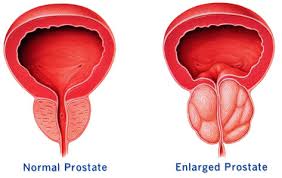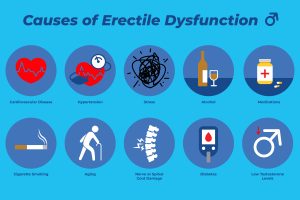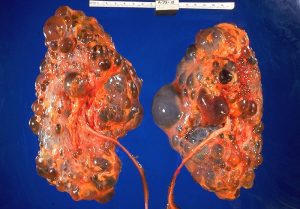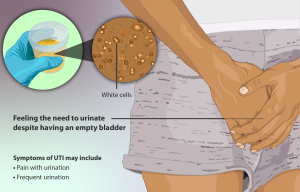2.3 Urinary System Pathologies
There are a number of pathologies that can affect the urinary system, and the most common pathologies will be discussed below. Many of these pathologies can be treated with medications that will be discussed later in this chapter.
Common Pathologies
Benign prostatic hyperplasia (BPH): The prostate normally doubles in size during puberty. At approximately age 25, it gradually begins to enlarge again. This enlargement does not usually cause problems; however, abnormal growth of the prostate, known as benign prostatic hyperplasia (BPH), can cause constriction of the urethra where it passes through the middle of the prostate gland. This can lead to a number of lower urinary tract symptoms, such as a frequent and intense urge to urinate, a weak stream, and a sensation that the bladder has not emptied completely. Fig. 2.4 shows a normal prostate and an enlarged prostate. By age 60, approximately 40% of men have some degree of BPH. By age 80, the number of affected individuals jumps to about 80%. Treatment for BPH attempts to relieve the pressure on the urethra so that urine can flow more normally. Mild to moderate symptoms are treated with medication, whereas severe enlargement of the prostate is treated with surgery in which a portion of the prostate is removed.

Chronic kidney disease: This condition causes the kidneys to stop functioning. Causes vary, and the cause may determine the course of treatment (Mayo Clinic, 2021). The following video gives a detailed explanation of kidney disease, its causes, and treatment options.
(Mayo Clinic, 2021)
Erectile dysfunction (ED): This is a condition in which a man has difficulty either initiating or maintaining an erection. The combined prevalence of minimal, moderate, and complete ED is approximately 40% in men at age 40 and reaches nearly 70% by age 70. In addition to aging, ED is associated with diabetes, vascular disease, psychiatric disorders, prostate disorders, the use of some drugs such as certain antidepressants, and problems with the testes resulting in a low concentration of testosterone. These physical and emotional conditions can lead to interruptions in the vasodilation pathway and result in the inability to achieve an erection. Fig. 2.5 shows various causes of ED.

Overactive bladder: This can be a very frustrating condition in which a person feels the urge to void frequently and at times may even experience urinary incontinence. It is important to seek medical attention to find the cause of overactive bladder. Certain conditions might play a significant role in this condition, such as multiple sclerosis, diabetes, bladder tumours, or an enlarged prostate, to name just a few. A physician might recommend behavioural modifications, managing pre-existing conditions, or introducing new medications to help treat overactive bladder (Mayo Clinic, 2023a).
Polycystic kidney disease (PKD): This genetic disorder causes fluid-filled cysts to grow within the kidneys. These cysts, in turn, can cause the kidneys to not function properly and lead to kidney failure. Fig. 2.6 is an image of a normal kidney and a kidney with PKD. Fig. 2.7 is an image of two kidneys with PKD, and you can clearly see the cyst formation on each of the kidneys. Treatment might include medications to treat hypertension and pain, as well as dialysis or a kidney transplant.


Prostate cancer: Another common disorder involving the prostate is prostate cancer. According to the Centers for Disease Control and Prevention (CDC), prostate cancer is the second most common cancer in men (CDC, 2022). However, some forms of prostate cancer grow very slowly, and thus may not ever require treatment. Aggressive forms of prostate cancer, in contrast, involve metastasis to vulnerable organs like the lungs and brain. There is no link between BPH and prostate cancer, but the symptoms are similar. Prostate cancer is detected by medical history, a blood test, and a rectal exam that allows physicians to palpate the prostate and check for unusual masses. If a mass is detected, the cancer diagnosis is confirmed by a biopsy of the cells.
Urinary tract infection (UTI): Urinary tract infections occur in the urinary system, most commonly in the bladder or urethra. They tend to be more common in females than males. Initial symptoms may include frequent urination and pain and burning when urinating. It is important to see a doctor immediately because if a UTI is not treated, the result may be additional health concerns, including kidney infection. A urinalysis will likely be performed (see Fig. 2.8), and if a UTI is found, an antibiotic medication will likely be ordered (Mayo Clinic, 2023b).

Attribution
Unless otherwise indicated, material on this page has been adapted from the following resource:
Ernstmeyer, K., & Christman, E. (Eds.). (2020). Nursing pharmacology. Chippewa Valley Technical College. https://wtcs.pressbooks.pub/pharmacology/, licensed under CC BY 4.0
References
Centers for Disease Control and Prevention (CDC). (2022). Prostate cancer. https://www.cdc.gov/cancer/prostate/index.htm
Mayo Clinic. (2023a). Overactive bladder. https://www.mayoclinic.org/diseases-conditions/overactive-bladder/symptoms-causes/syc-20355715#:~:text=Overactive%20bladder%2C%20also%20called%20OAB,of%20urine%20(urgency%20incontinence)
Mayo Clinic. (2023b). Urinary tract infection (UTI). https://www.mayoclinic.org/diseases-conditions/urinary-tract-infection/symptoms-causes/syc-20353447
Mayo Clinic. (2021, December 16). Mayo Clinic explains kidney disease [Video]. YouTube. https://www.youtube.com/watch?v=OVk4YXwJp98&t=2s
Image Credits (images are listed in order of appearance)
Normal and enlarged prostate by ناطق1, CC BY-SA 3.0
Common causes of erectile dysfunction by Click2pharmacy.co.uk, CC BY 2.0
Polycystic Kidney by BruceBlaus, CC BY-SA 4.0
Polycystic kidneys, gross pathology 20G0027 lores by CDC/Dr. Edwin P. Ewing, Jr., Public domain
Depiction of a lady who has a Urinary Tract Infection (UTI) by myUpchar, CC BY-SA 4.0
the inability to hold urine or control urination

